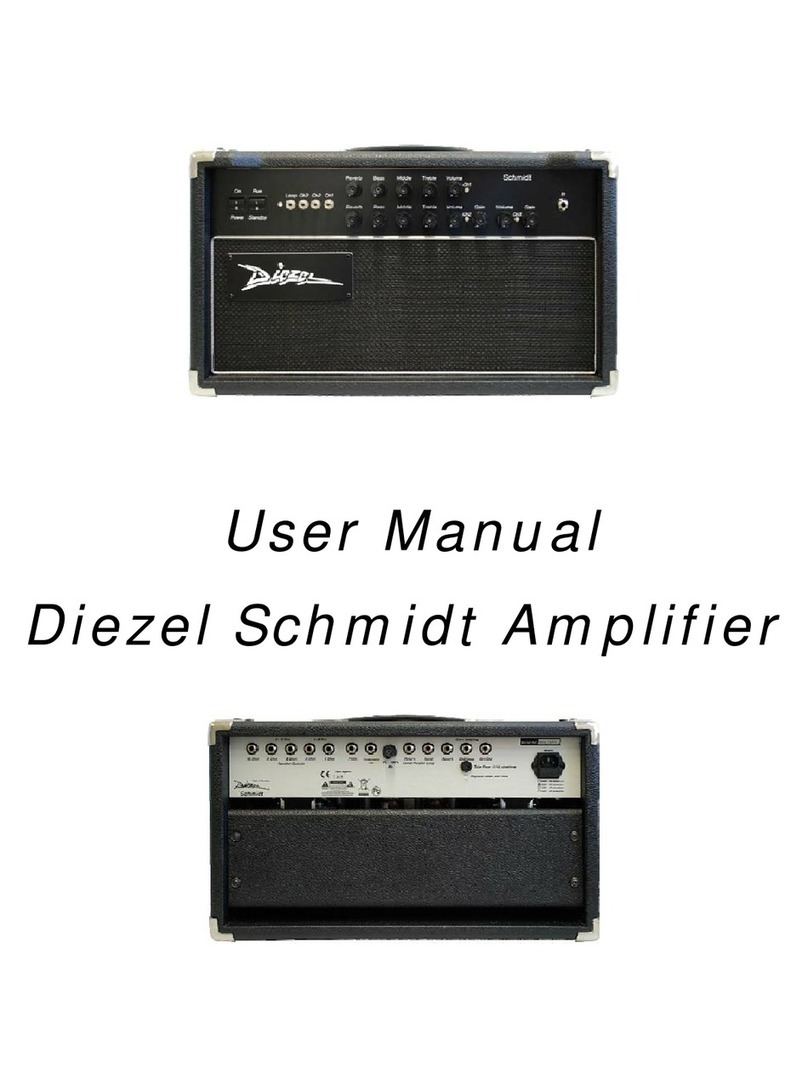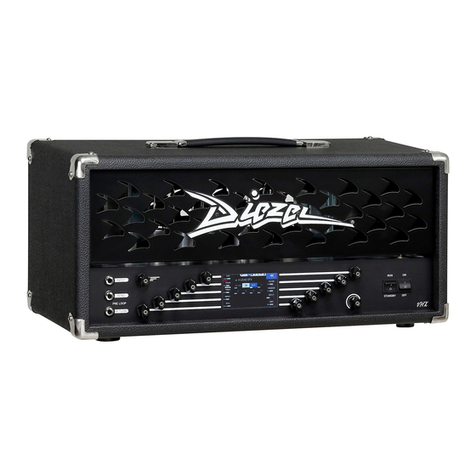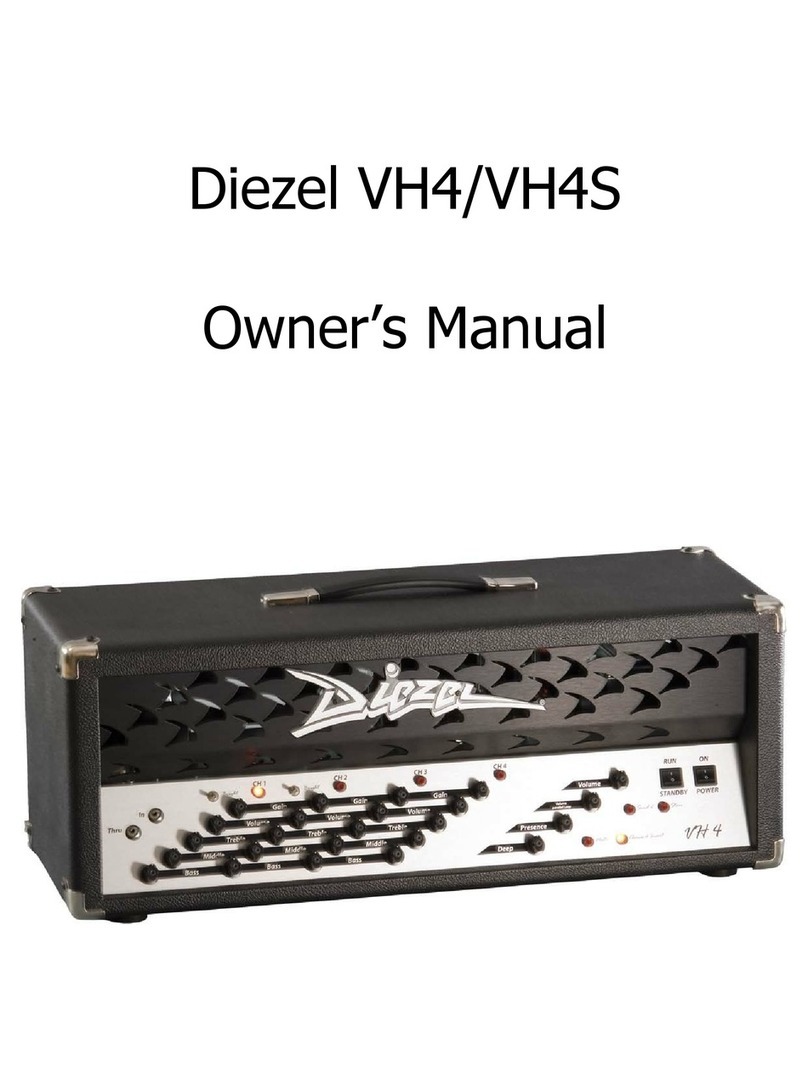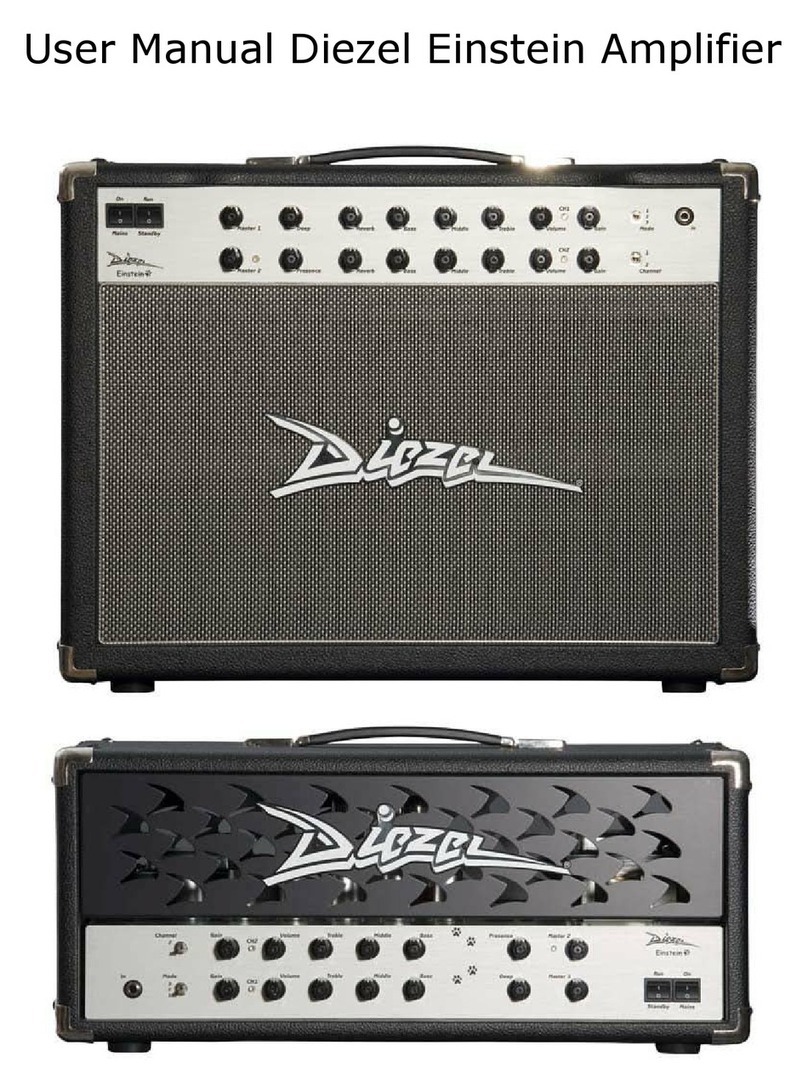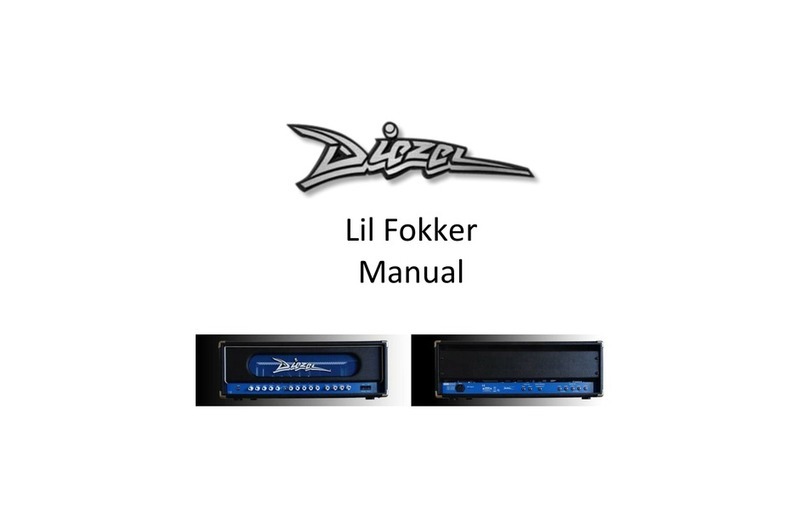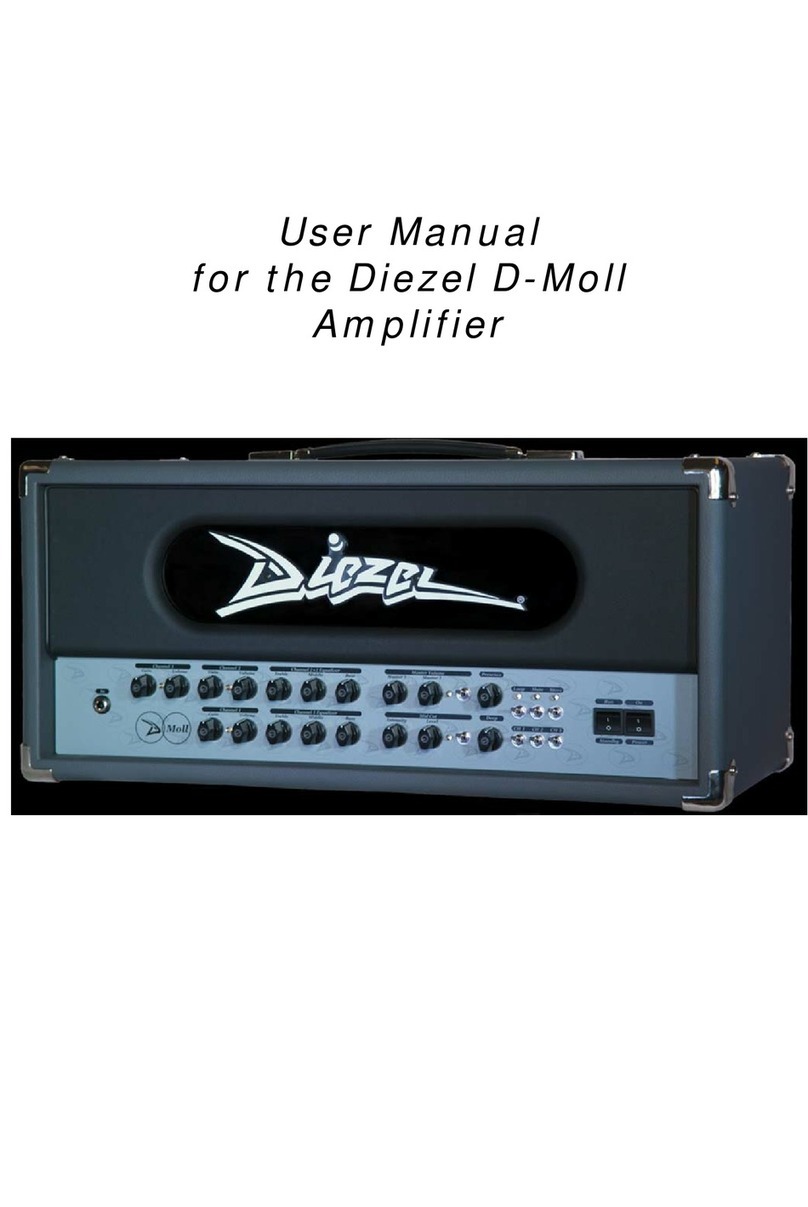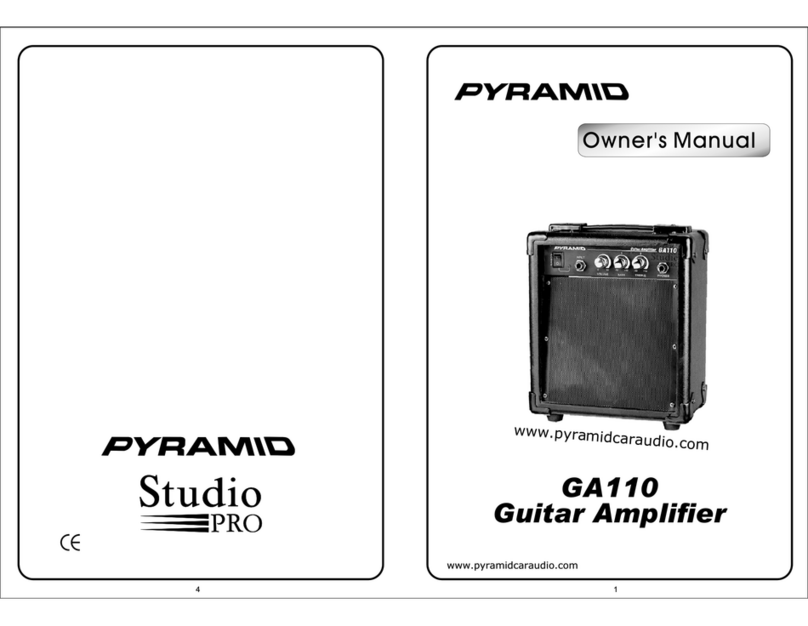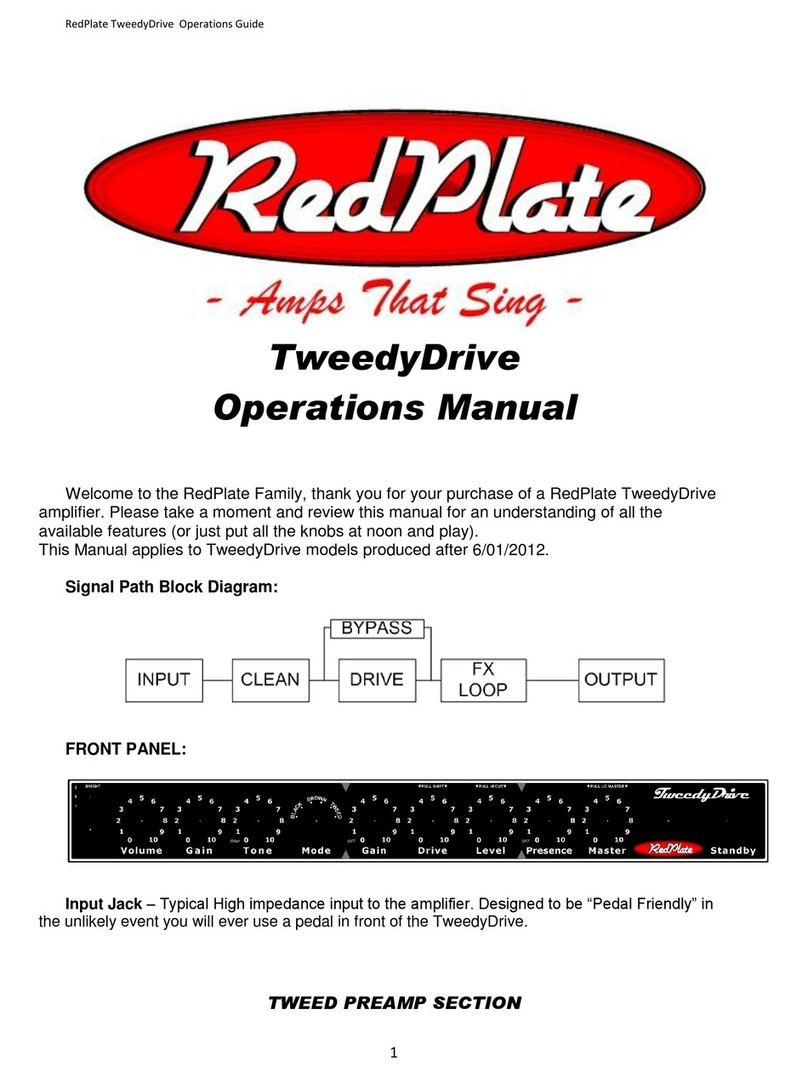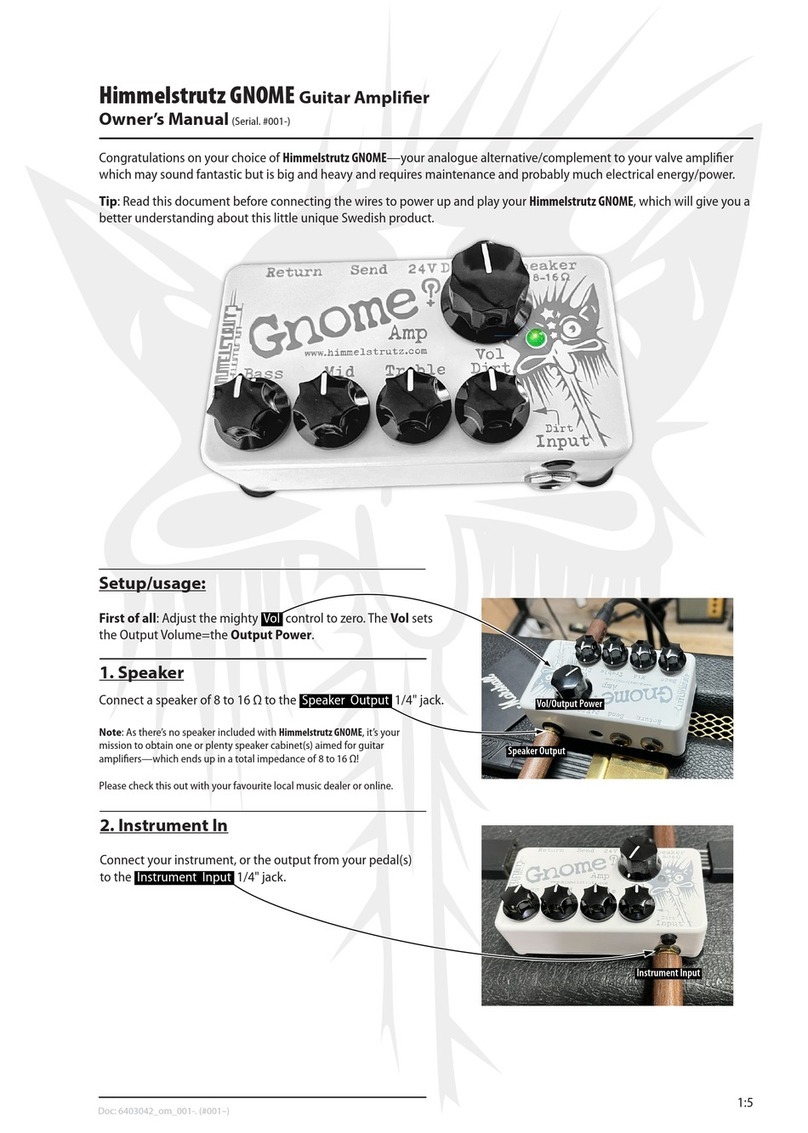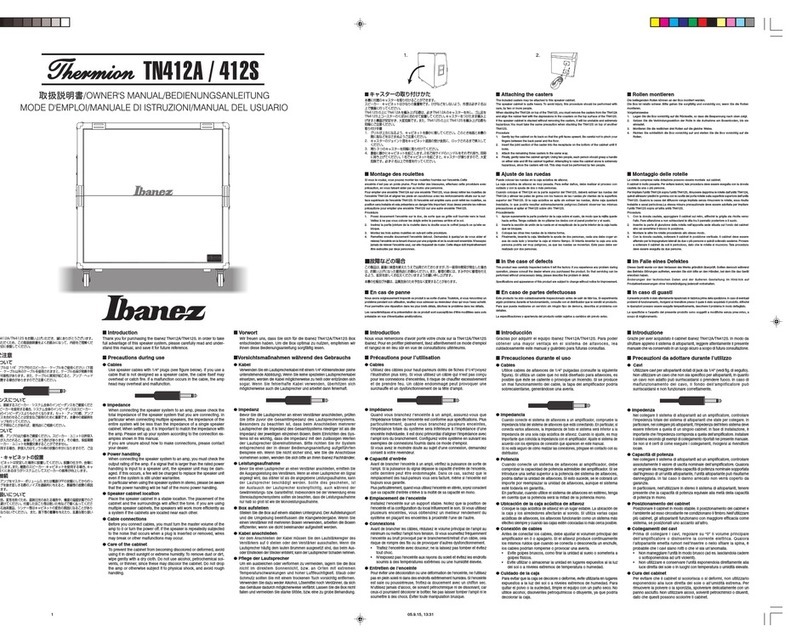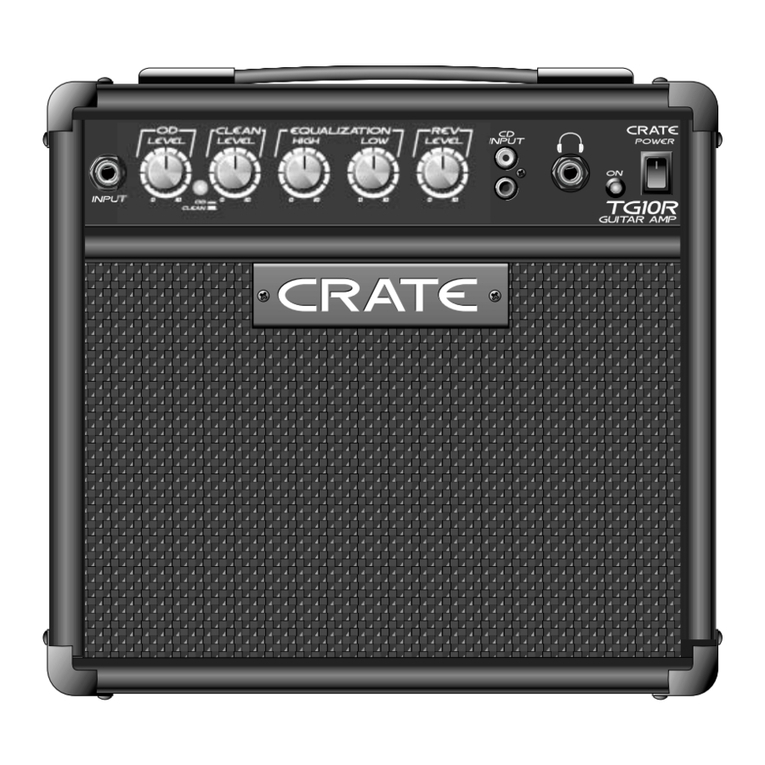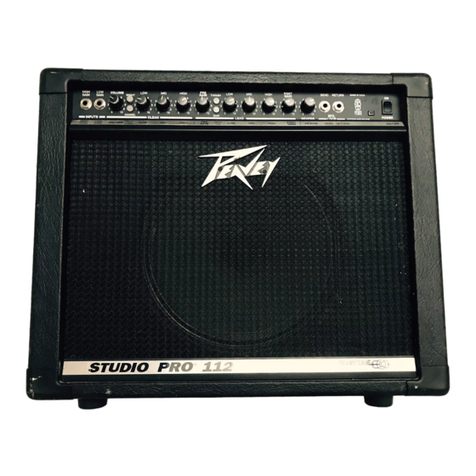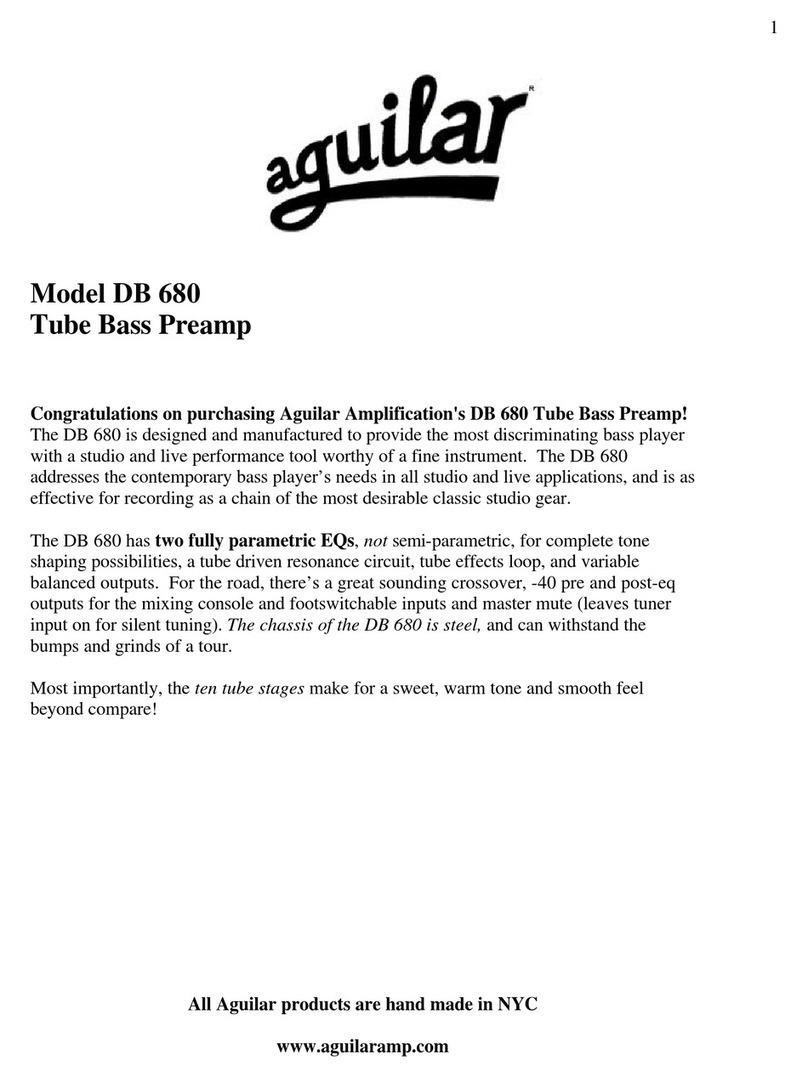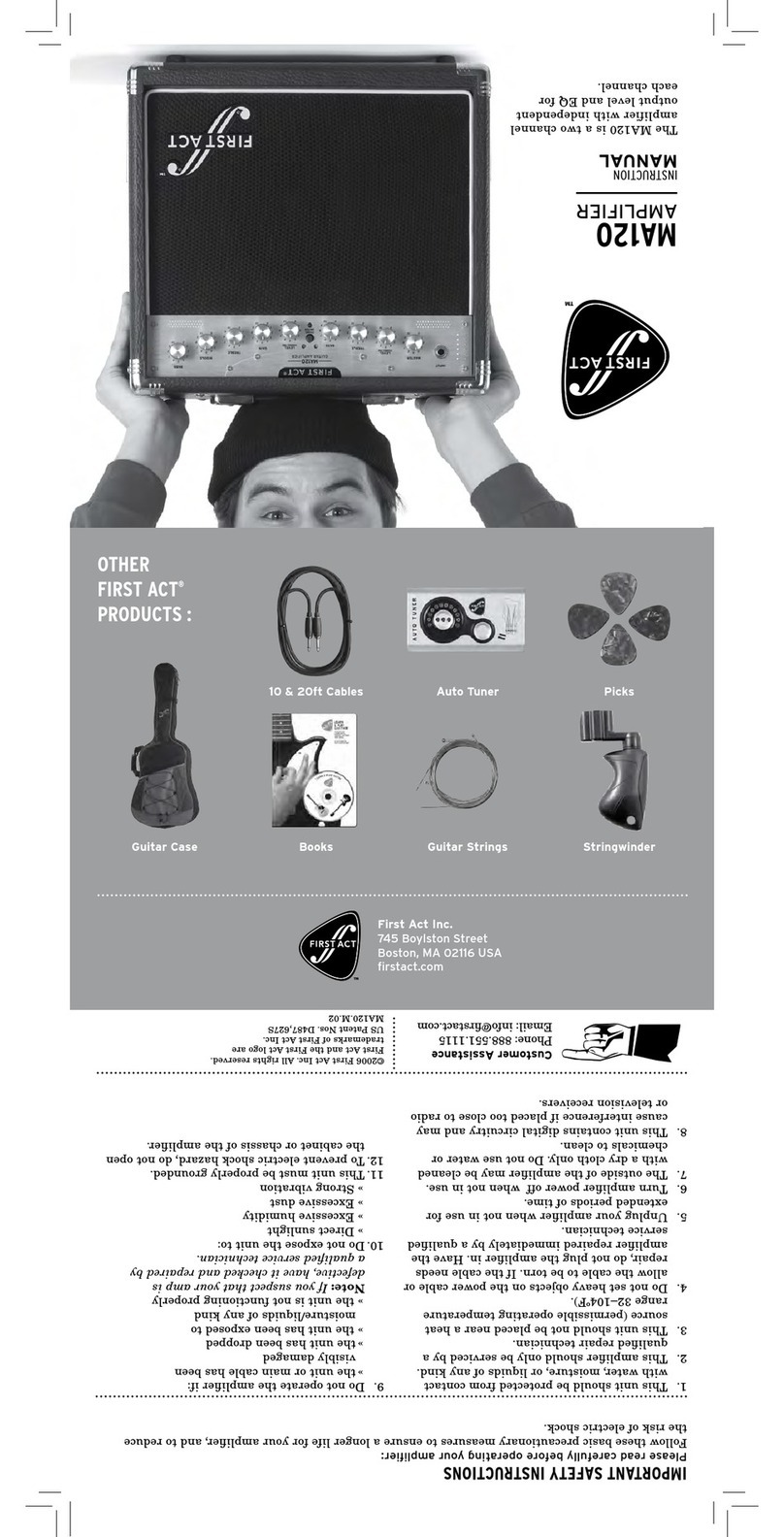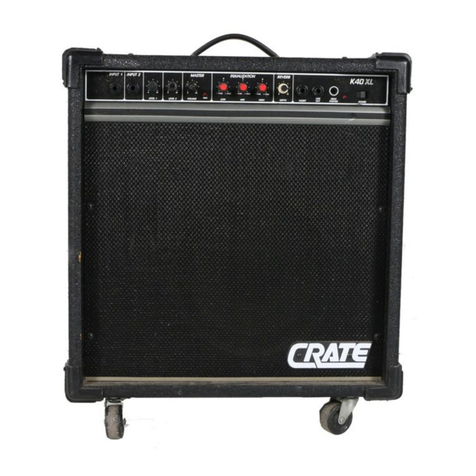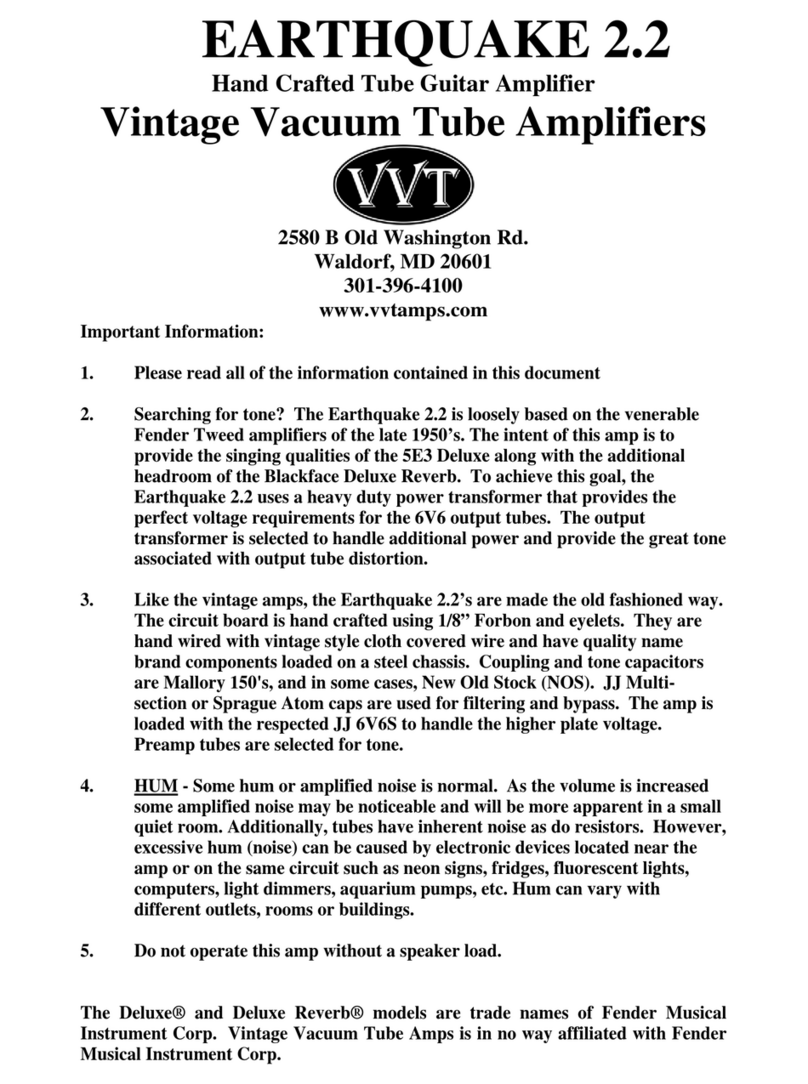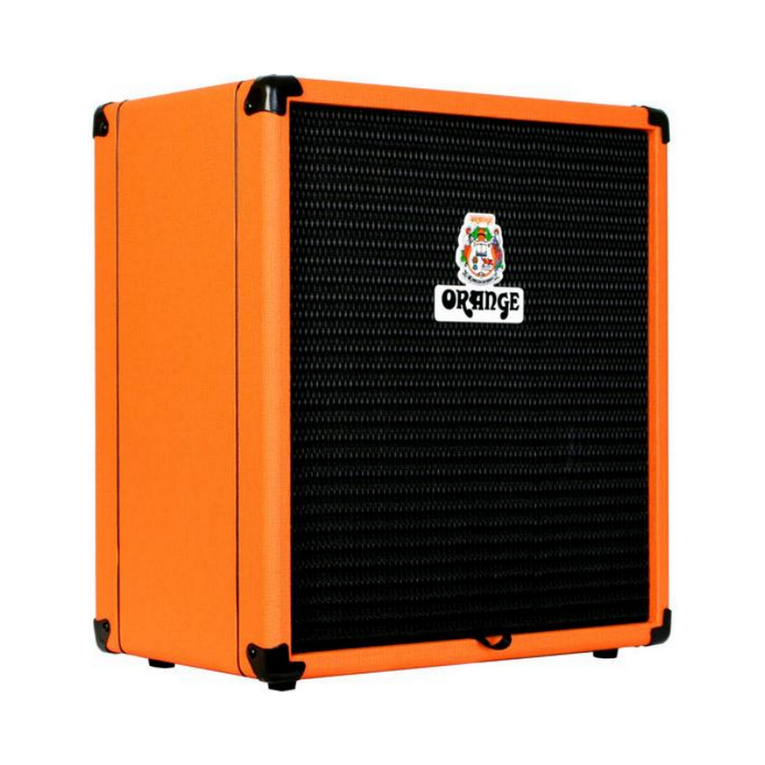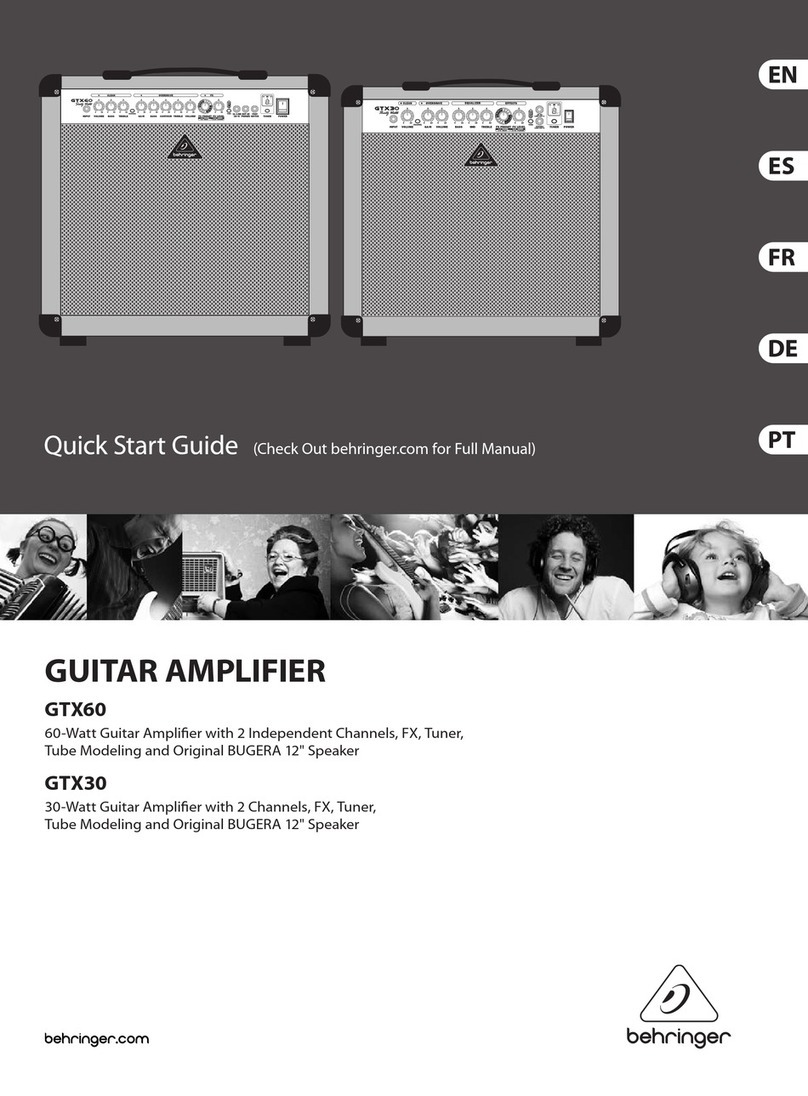Diezel Herbert User manual

Diezel User Manual for the Herbert Amplifier
Diezel USA
Salwender International
1147 W. Collins Ave.
Orange CA 92867
714-538-1285

Table of Contents
Chapter One: Safety and Warranty
1.1 Safety Warnings
1.2 Warranty Information
Chapter Two: Using Your Herbert
2.1 Mains Connections, Power and Standby
2.1.1 Mains/connect to power outlet
2.1.2 Power up, Warm up, Standby off
2.1.3 Power tube caution
2.1.4 Operating Temperature
2.1.5 Power Tube Information
Chapter Three: Peripheral Connections
3.1 Front Panel Connections
3.1.1 Signal In
3.1.2 Connection Information
3.1.3 Cable Selection
3.2 Rear Panel Connections
3.2.1 Send/Return Loop
3.2.2 Parallel and Serial Return
3.2.3 Switch-able Loop as additional Volume Control
3.2.4 Switch-able Loop for external Pre-Amp
3.2.5 Switch-able Loop as switch for parallel Loop
3.2.6 Tuner Out
3.2.7 Compensated Out
3.2.8 Speaker Connections
3.2.9 Reasons for Dynamic Losses in the Effects Loop
3.3 MIDI Connections
3.3.1 MIDI In
3.3.2 MIDI Thru
Chapter Four: The Three Pre-Amplifiers
4.1 Pre-Amplifier Duties
4.1.1 Channel One
4.1.2 Channel Two
4.1.3 Channel Three
4.2 Pre-Amplifier Tubes
4.3 Noise and Microphonics

Chapter Five: Power Amplifier
5.1 Tone and Volume of the Power Amplifier
5.1.1 Master Volume
5.1.2 Presence
5.1.3 Deep
5.2 Power Amplifier Tubes
5.2.1 Function
5.2.2 Selection
5.2.3 Life Span
Chapter Six: Functions and Switches
6.1 Programming Herbert
6.2 Manual Channel Selection
6.3 Mid Cut on/off
6.4 Loop on/off
6.5 Mute on/off
6.6 Master 2
6.7 Store
Chapter Seven: Midi
7.1 MIDI
7.2 MIDI In
7.3 MIDI Thru
7.4 MIDI Communication
7.4.1 Omni Mode
7.4.2 Single Channel Mode – automatic Channel Recognition
7.4.3 Single Channel Mode – manual Channel selection
7.5 Program Information
7.6 Phantom Power
Chapter Eight: Remote Switch
Chapter Nine: Maintenance and Cleaning
9.1 Cleaning
9.2 Care
9.3 Tube Change

Chapter One: Safety and Warranty
1.1 Safety Warnings
We would like to stress the importance of the following points, for reasons of
your personal safety, product longevity and product liability.
• Do not use the amplifier in or near wet locations
• Do not store the amplifier in damp or wet locations
• Do not operate the Amplifier on voltages other than those designated on
the rear panel of the amplifier.
• Do not open the panels of the amplifier. No user serviceable parts inside.
Your Herbert operates on very high internal voltages, which may still be present
after the Amplifier has been turned off and disconnected for a while.
• Do not use the Amplifier for anything other than its design purpose: To
Amplify Electric Guitar Signals!
• Do not use fuses other than those intended and specified for the amplifier
• Do not use 2-conductor extension cords or anything other than 3-pole g
rounded outlets for this Appliance. Your life may depend on it!
Please observe the following points when transporting your Herbert:
Herbert is a Tube Powered Amplifier; therefore it is sensitive to shock, especially
after playing the amplifier for a while. Please store and transport your amplifier
gently, and try and avoid temperature extremes in storage, which might cause
condensation resulting in moisture on internal components. Usually a 60 Minute
acclimatization period is sufficient to ensure safe operation.
The Amplifier should be stored in a controlled environment, and it should be
transported in a suitable flight case. Make sure the Amplifier gets transported in
its normal operating position, not upside down or on its side.
The Herbert’s Design incorporates a very potent power amplifier. It is configured
to deliver satisfying guitar tone at most volume levels, from a small bedroom to a
large arena. In its normal operational volume level (75-80dB) it will provide
beautiful tones with very little coloration. For reasons of your own personal
health, please do not run the amplifier above these levels for extended periods of
time without wearing hearing protection. Hearing Loss is a long -term problem,
and is normally not curable.

1.2 Warranty
Diezel GmbH of Munich, Germany offers a 1-year transferable warranty on the
product “Herbert”. Diezel GmbH of Munich offers a lifetime non-transferable
warranty to the ORIGINAL purchaser of the product: “Herbert”. The product
must be registered and a dated sales receipt must accompany the registration.
Excluded from this warranty are all vacuum tubes, and any abuse of the amplifier.
Also excluded from this warranty are damages due to not following the Safety
Warnings in 1.1 above.
Diezel USA is the local executor of this warranty. Customer is responsible for
shipping charges to Diezel USA in Orange, California, unless other arrangements
are made in advance.
Chapter Two: Using Your Herbert
2.1 Mains Connections, Power and Standby
2.1.1 Mains/Connection to Power Outlet
Please make sure that both switches (Power and Standby) are in the off position
before connecting to the Mains circuit. Verify line voltage before connecting the
power cord. Never start Herbert without speakers being connected to the proper
terminals. (See 3.2.8)
2.1.2 Power up, Warm up, Standby off
First turn the Power switch to on (facing up). The indicator will light up. This
starts the tube heating process. After about 40 seconds, the tubes have
sufficiently heated for normal operation. Your Herbert is now ready for operation
and the standby switch can be turned to “run” (also facing up). Premature
activation of the standby switch will lead to unnecessary tube stress and
subsequent reduction of the power tube’s life span.
2.1.3 Power Tube Caution
Tubes are electronic components that only function with vacuum intact and under
very high operating temperatures. Each tube has one or more heating filaments,
much like a light bulb. These filaments heat up the Anode of the tube. If you
switch the standby switch before these Anodes have reached their operating
temperature then the Anode surfaces are not heated evenly yet; the “operating
temperature” of the tube is not reached yet. This causes undue stress on the tubes
and their related components inside the amp. One should therefore always give
the amp it’s much needed warm-up time, even if musical inspiration hits with full
force.

2.1.4 Operating Temperature
It will take a little more time after warm-up until everything inside the amp is
working in sync and to it’s fullest potential. A trained ear will notice a slightly
warmer tone and better complexity in tone after playing the amp for a short while.
It’s like warming up before running a marathon. Get it?
2.1.5 Power Tube Life
The power tubes of your amplifier are subject to a certain aging process. Once
one of the tubes shows signs of aging, unreliability or unusual noise, then we
suggest that you replace all power tubes. Matched tube sets wear relatively even,
or so our experience suggests. This means if one goes, the others are not far from
meeting the same fate.
The aging process manifests itself by a depletion of a thin layer of Wolfram on
the Anodes. This can take anywhere from 6 month to 3 years, depending on the
amount of use of the amplifier. The amount of wear is determined by the amount
of performance that is asked from the tube.
Chapter Three: Peripheral Connections
3.1 Front Panel Connections
3.1.1 The input jack (“IN”) receives your Electric Guitar signal by means of a shielded
guitar cord with 1/4” mono style plug.
Your guitar cord is an important part of your signal chain and its quality and
construction type clearly affect the overall tone of your rig. Try and buy the best
quality guitar cord that you can or want to afford. Call us if you have doubts and
need recommendations. This is where the smart “weak link” comment comes in.
Get it?
3.1.2 Cable ABC
Some cords and cables sound very neutral; others color the sound spectrum and/or
attenuate high frequencies due to capacitance inside the wire and shield. What are
we talking about? OK. A capacitor is used in electronic crossovers, amongst other
things, to divide low and high frequencies. Capacitance in a cable therefore cuts
your guitar’s high end to a certain degree. Generally, the longer of a cord you
use, the more of the cords inherent characteristics will be audible.

3.1.3 Cable Selection
In certain instances it is desirable to match a guitar cord to a specific instrument.
One can use the otherwise undesirable qualities of a cord to one’s advantage, if
one has the time and patience to experiment with different cords and guitars. You
should do this when playing with a band or when you are recording. Sometimes it
is difficult to tell a component’s true advantages until it is used in the right
context.
A guitar that has very piercing highs could theoretically be tamed down somewhat
by the use of a long guitar cord that offers some high-end attenuation.
The loops of your Diezel Herbert send signals at higher levels and impedances,
which makes this section of wiring less sensitive. You should still use reliable and
good quality wiring for all loops and inserts.
3.2 Rear Panel Connections
3.2.1 Send/Return Loop
The System consists of 3 separate Loops. It allows creation of effects path in
either serial, parallel, or switched configurations. The individual channel volume
controls determine the signal strength at the send jacks. The range is - ... to
+10dB. The output impedance is 4.7 kΩ. If you want to use the loops, then
connect the “Send” to the input of the Effects unit. Be sure and adjust the input
level of the effects unit to the amplifiers level. Most effects units have led bar or
other level control devices. The Output of the effects unit must be connected to
one of the return jacks, parallel, switched, or serial. If you use the parallel return,
then the signal can be mixed to the original signal via the rear panel mounted
“Volume” control.
3.2.2 Parallel or Serial
Which is better for you? Read on.
There are 2 ways to handle effects signals. If you use the serial return, then the
signal path of your Herbert is interrupted, the signal is sent to the processor, gets
more or less processed, then sent back to the serial return into the power amp.
Digital effects units often digitize this signal, then process it, then convert it back
to analog, then send it to the amp. This is called ADA conversion. It is necessary
for digital effects units to do this to your guitar signal, so that it becomes a digital
code, which the processor can read and understand. Your tubes, however, need an
old fashioned analog signal, so the processor needs to convert the signal back to
analog before it goes back to the amp. Generally, even in highest quality effects
processors, this causes a change in the original signal, typically a loss of tonality
and warmth, also noticeable as a “harder” sound.

When you use the serial loop for an effects unit like this, then your signal will
have been ADA converted at least once. Tone junkies and vintage freaks alike
will more than likely have hives developing by now. But, as always, there is a
better way. Using the Parallel loop and the mix (labeled “Volume”) control on the
back determines how much effect signal is being added to the original signal,
which now still flows through the amplifier. There is always an analog connection
between the send and return jacks: a parallel loop!
Important: You must set the mix control on the effects unit to 100% wet when
using the parallel loop. Otherwise there will be nasty phasing problems resulting
in unsatisfactory tone. The signal portion that is unaffected by the mix control in
the effects unit would reach the amplifier at a different time due to the cabling,
and cause phasing cancellations.
3.2.3 Switch-able Loop as additional Volume Control
Those of you who can live without processors in the parallel loop can use this
loop for a second master volume for each channel.
To do this, just loop a short 1/4” cable from the switch-able send to parallel loop
return. Now you can choose a second master volume by turning the mix control
past 1:00 PM to full open, and push the ‘ Loop” button to activate your second
master volume. Now, with the loop activated, the mix control can act as another
way to control volume.
3.2.4 Switch-able Loop for external pre-amp
One might extend one’s tonal variety by hooking up an external guitar pre-amp to
the switch-able return jack. Now the external preamp, once selected via the
“Loop” function, can feed the Herbert’s power amp.
3.2.5 Switch-able Parallel Loop
To route your effects signal parallel to the original signal, connect the switch-able
send to the input of your effects unit and go from the output of your effects unit to
the parallel return. Now you can switch the send to the effects unit on and off via
midi, with the effects signal decaying naturally when the loop is turned off.
3.2.6 Tuner Out
You guessed it – it’s for a guitar tuner. Stays lit while mute is activated. So you
can tune without annoying your band members, or the audience. Elegant, no?

3.2.7 Compensated Out
A frequency corrected signal will leave this jack if you connect it to a mixer or
recording device. Use it to quietly compose or send an auxiliary signal to a
console etc. For quiet sessions, just turn the master volumes to “0”. Recording a
loudspeaker through a microphone is the preferred choice of recording engineers.
The compensated out was designed as an alternative for those of you that don’t
have a studio at your fingertips.
3.2.8 Speaker Connections
Herbert has 5 speaker jacks: 1 for a 16-Ohm load, 2 for 2 16-Ohm loads or 1 8-
Ohm load, and 2 for 2 8-Ohm loads or 1 4-Ohm load. Confusing? Oh, yes!
Just do what it says on the jacks, and you’ll be fine
3.2.9 Top 5 Reasons for dynamic losses in the effects loop
Many different factors can be responsible for loss of dynamics, aside from those
mentioned in 3.2.2 (ADA conversion). A vital point that often leads to frustration
is a maladjusted output level of an effects unit. If the output level is too high, then
unwanted distortion is caused in the power amp. If it is too low, then the rig will
not sound punchy and might get lost easily in the band sound. When used in the
serial loop, the output of the effects unit determines the ultimate drive signal
strength of the power amp. The output level should be matched to give the best
possible sound with all 3 channels without over driving the power amp section.
Headroom adjustments of 10% are usually sufficient.
3.3 MIDI Connections
3.3.1 MIDI In
Midi in receives “program change” orders from commonly available midi pedals
and control systems. The Herbert is able to supply phantom power to your midi
pedal via a 7-prong DIN midi cable. This can help unclutter your stage system
and rids the artist of these pesky power supplies.
Pin 1 and 6 is ground (-)
Pin 3 and 7 is hot (+)
The voltage is 9-12V AC or DC, which is acceptable for 98% of all midi pedals.
Maximum power usage of the pedal cannot exceed 800mA (0.8A)
Please observe proper polarity to avoid damage to the MIDI pedal.

3.3.2 MIDI Thru
This jack routes the midi signal to other midi partners. MIDI data not addressed to
the Herbert gets looped through this jack.
See chapter 7 for MIDI programming instructions
Chapter Four: Three Pre-Amplifiers
4.1 Pre-Amplifiers and their Functions
The Diezel Herbert comes equipped with 3 different and totally independent
preamps. This allows the artist to play every conceivable musical style without
having to make major changes to his or her amplifier. The preamps are voiced to
deliver the 3 most wanted guitar tone flavors: 1-Clean, 2-Crunch/Heavy 3- Lead.
This concept delivers 3 stellar guitar sounds with excellent playability, warm
dynamics and razor sharp equalization possibilities. The tone controls work in an
unusually wide range, so a little adjustment goes a long way. As with so many
other things - less is often more. We suggest you start exploring the channels with
all controls set to 12:00 o’clock, and the master volume just slightly cracked open.
(To avoid hearing damage)
4.1.1 Channel One (Clean Tone)
Clean Tone is a very sensitive subject, because there are so many different ideas
on how a clean amp should sound like. Clean tonal textures require much higher
dynamic range than distorted sounds. From hard and percussive sounds to soft
and warm blossoming tones. Herbert was designed to offer as many of the clean
variety as possible. Your choice of guitars and pickups will have a large part in
this equation.
4.1.2 Channel Two (Crunch)
This channel’s main objective is to cover soft and heavy overdrive and distortion
sounds. It features a voicing switch, with -/+ settings. With the (-) setting selected,
blues and classic rock sounds can easily be realized. The (+) setting kicks
everything up a few notches and offers crunch with a good bite, allowing you to
dial in punchy heavy rhythm and searing solo tones.

4.1.3 Channel Three (Lead)
This channel is voiced for highly articulate single note lines or for very heavy and
massive rhythm guitar. Due to its slight midrange accent and very high gain
structure, it possesses good punch and will, with ease and authority, rule any stage
or studio. The “less is often more” rule applies here also.
4.1.4 Mid Cut
The section Mid Cut incorporates controls for Intensity and Level. Designed for
friends of Heavy or Nu-Metal type musical styles, the Intensity control attenuates
low midrange at approximately 400Hz. To compensate for the inevitable volume
loss when activating this feature, one can bring the volume level back up with the
Level Control.
This Mid Cut function is MIDI assignable and can therefore be assigned to any or
all of the three channels. If you don’t want to use the Mid Cut function, then it can
be used as an additional programmable volume control with the Intensity control
set to 0 or off. This gives your Herbert 8 programmable volume options!
4.2 Pre-amp Tubes
The pre-amps are equipped with 12AX7 tubes in all positions, except the phase
inverter, which is a 12AT7. The pre-amp tubes are not used to make big power,
but merely as pre-amplifiers. Therefore their life expectancy is much higher than
that of the power amplifier tubes.
This is not to undermine their utter importance in overall sound and response of
the amplifier. Also, many nuisance defects like crackling noises and low
dynamics are directly related to defective pre-amp tubes. Like all other tubes,
12AX7 tubes come in many different gain stages, and offer a wide variety of tonal
behavior. Our choice for production was made to ensure a wide variety of tones,
with low noise and, hopefully, excellent reliability.
4.3 Microphonics and Bad Noises
The overall performance of pre-amp tubes is easily influenced by mechanical
factors from the outside. This would manifest itself by a sudden feedback sound
with high pitch. The input stage is especially suspect to this phenomenon. If one
encounters microphonic tube behavior, then the first tube should be checked as a
rule. Pre-Amplifier tubes can also cause hum or other bad noises, like crackling or
ticking.

Chapter Five: Power Amplifier
5.1 Tone and Volume of the Power Amplifier
5.1.1 Master Volume
As the name suggests, this controls the overall, global volume of the amplifier.
For your enjoyment, there is also a second programmable master volume control,
which allows volume adjustments via remote control while you are playing. Both
controls are laid out so that even a low-performance effects unit can be used and
amplified in the loops.
5.1.2 Presence
This knob controls frequencies over 3KHz. Treble is produced and dispersed in a
very small beam from the speaker, so be sure to position yourself in the projection
area of the speaker when making adjustments.
5.1.3 Deep
The Deep control is an active bass control, contrary to conventional bass controls.
It controls the frequencies around 120Hz without influencing the overall dynamic
range of the power amplifier. Diezel Co. is not responsible for disintegrating
speaker cabinets.
5.2 Power Amplifier Tubes
5.2.1 Function
As the name suggests, the power amp section is the part of the amplifier that
produces output power, measured in watts. Preamp signals are sent to the power
amp(s), which amplifies this signal to a level that is acceptable for loudspeakers.
Guitar amplifiers utilize several different types of power amps, which differ in
output power and tone. We chose the tube type power amplifier for its tried-and-
true performance and familiar tonal behavior.
5.2.2 Selection
Diezel Co. installs the most reliable and best sounding tubes that are currently
available in sufficient quantities. So it is possible that tube brand and tube type
will change during production. You can fine-tune your Herbert by having
different type and brands of tubes installed, however, it is imperative that the amp
is biased properly. Herbert utilizes 6 power tubes, organized in 3 pairs with triple
bias possibility. This allows use of 3 different pairs of power tubes, either the
same or different types. Yes, this means that you can mix 6550’s with EL34’s, or
6L6’s with KT88’s etc. Cool, no?

A quick and general overview of the most common tube types for use in the
Herbert:
EL34/6CA7: Aggressive, slender low end, higher total harmonic
distortion… Recommended bias setting: 30-35mA
5881/6L6: Great tube for clean sounds, good bluesy tones, also has
strong bass and excellent clarity… Recommended bias
setting: 25-35mA
6550: Very loud, very good dynamics, strong low end, amazingly
percussive… Recommended bias: 40-60mA
KT88/KT100: Similar to 6550, but very punchy with great clarity and
warmth… Expensive… Recommended bias: 35-50mA
5.2.3 Life Span
Power tubes last 1 to 3 years, depending on care, volume and frequency of use of
the amplifier. If you use your amp only once a month, then the tubes will
obviously last longer. Really… We have heard tubes that are over 10 years old,
but it was not a good thing. Tubes age in a very slow manner, slow enough for the
artist to get used to the changing tone. To keep things fresh and to keep your tube
dealer in business, we recommend re-tubing, cleaning and biasing once a year if
the amp is used frequently.
Chapter Six: Functions and Switches
6.1 Programming the Herbert
It is quite easy to program your Diezel Herbert and, also, easy to explain. Pushing
the “Store” toggle switch twice must follow each change in the MIDI program.
After the first click, the selected blue LED lights will blink. Click on the switch
again and your program is in memory. Each of the 128 programs (patches,
program changes) can be changed as often as is desired.

6.2 Manual Channel Selection
The 3 channels of the Herbert can be selected manually by activating the red
button above each channel strip, or can be programmed via the midi control
system. If you assign the Channel one switch function to a MIDI program (for
example “01”), then you can initiate this channel’s switching via your MIDI
pedal. Push “01” on your MIDI pedal after programming, and the pedal will send
digital information to the amplifier. The amp will read this information and decide
whether or not it is supposed to respond. When properly programmed, it will then
switch on channel one.
OK, here it is again:
Select 01 on your MIDI pedal. Select channel one of the Herbert. Now push
“Store” twice. Voila, it’s a MIDI program! Now select program change “02” on
your pedal, switch the amp to channel two, hit “Store” twice, and suddenly you
have a MIDI pedal controller with 2 program changes. Continue on until you run
out of channels, about 1 more time.
All the other functions of the amp can be programmed in the same exact way.
Remember: push “Store” twice to finalize a MIDI program procedure. Select the
program on the pedal to recall the setting from the amp.
6.3 Mid Cut On/Off
The switching function “Mid Cut” is applicable to all channels. The Mid Cut is
active when the corresponding LED is lit.
6.4 Loop On/Off
This function activates a device that is connected to the switch-able loop.
6.5 Mute On/Off
“Mute” silences the beast. “Tuner Out” stays active. Makes sense, no?
6.6 Master 2 On/Off
Master 2 can be used for all channels, much like the Mid Cut function.

6.7 Store
As discussed earlier, this is the universal programming button. Activating this
button twice will verify an intended program procedure. In case you have pushed
this button once by accident, or if you have started to program and don’t want to
anymore for whatever reason, then you can push any other switch (any switch but
the “Store” switch) to cancel the programming procedure. The previously
established program will be preserved. On models equipped with GPS, this will
call out the quickest way to a near by music store.
Chapter Seven: MIDI
7.1 MIDI
MIDI is an acronym for Musical Instruments Digital Interface and is an
internationally accepted communications system between musical instruments
(and processors and computers) of all kinds. We will only need to learn a small
portion of this “language” to use the Herbert and its peripheral MIDI partners. We
are going to learn only about “program change”.
7.2 MIDI In
MIDI In is a 7-pole DIN jack. It must be connected to the MIDI Out jack of your
foot controller (or MIDI pedal), or the MIDI Out of any effects unit connected to
the pedal directly.
7.3 MIDI Thru
Connect this port to the midi in of other units to continue the MIDI chain
7.4 MIDI Communication
7.4.1 Omni Mode
The Omni mode will allow reading of MIDI information on all 7 channels.
It is an easy way to get into the MIDI system but it is not advisable if more MIDI
partners on different channels are in the same system. Then a certain MIDI
channel should be assigned to the Herbert and its program changes should be
restricted to this channel (See 7.4.2). To put the amp into the Omni mode, hold
the “Mute” switch down and activate the “Master 2” switch quickly and then
release the mute switch. The Mid Cut, Master 2, Loop and Store LED’s will now
blink to verify that the Omni mode is being accepted. This function needs to be
disabled under some circumstances in order to use single mode automatic or
single mode manual.

7.4.2 Single Channel Mode – Automatic Channel Recognition
Your Herbert can automatically recognize the pedal’s send/receive channel. To
get your amp into the mood (or mode) for this, push and hold “Mute” and then
activate any program change button on your MIDI pedal. The amp will look for a
program change and recognize the channel it is being sent on. Then it will switch
to this channel and stay there as soon as you let go of “Mute”.
7.4.3 Single Channel Mode – Manual Channel Selection
If you would like to have your Herbert on a certain MIDI channel, then we can
accommodate you here as well. Here is how this works:
Push and hold “Mute” and then turn on the preamp channels in the order that
corresponds to your midi channel preference. For example: if you want to have
your Herbert to respond only to MIDI information that is being sent on channel 7,
then you must hold the “Mute” button down and turn the Preamp channel one
selector off, channel two selector on, channel 3 selector on. If you let go of
“Mute” now, then your Herbert is set to respond to MIDI channel 7 only. Get it?
The table below gives you the sequence for all 7 MIDI channels.
Ch.1 off off off
Ch.2 on off off
Ch.3 off on off
Ch.4 on on off
Ch.5 off off on
Ch.6 on off on
Ch.7 off on on
7.5 Program Information
Herbert can remember up to 128 program changes.
7.6 Phantom Power
Several of the pins in the MIDI jack can supply phantom power to your MIDI
pedal, as explained in chapter 3.3.1
Chapter Eight: Remote 7
The optional Remote 7 footswitch can be connected via the rear panel mounted
XLR jack. The Remote 7 will not recognize functions selected from the front
panel. To reset, just unplug and plug in the Remote 7.
Remote 7 will be available soon. Please check with your local Diezel Dealer.

Chapter Nine: Maintenance and Cleaning
9.1 Cleaning
Never use a wet method of cleaning the amplifier, i.e. any amplifier. Usually it is
sufficient to wipe down the outside of the amp with a slightly moist cleaning rag.
Do not use abrasive cleaning chemicals. Sometimes a vacuum cleaner can be used
to remove dust and dirt from nooks and crevices. Do not remove the chassis from
the housing to clean the amp. The inside of your amp carries dangerous voltages.
9.2 Care
Be gentle with this amplifier. Any mechanical shocks and wide temperature
changes, moisture-rich environments and extreme conditions (dust, wind, heat,
cold, moisture) can substantially shorten tube life, in some cases, even amplifier
life.
Do not block the air circulation grilles in the front and in the back of the amp. Do
not push the amp right up against objects that would interfere with its normal
airflow. The top of the amplifier might get warm after prolonged use, this is
normal, but will melt your ice cream and definitely ruin your beer. Never put
beverages on top of the amp where they could spill and flow inside the amplifier.
You’ll hate it if this happens, guaranteed!
9.3 Tube Change
Tube changes are only to be undertaken by authorized service personnel. If
power tubes with different values then the original ones are to be installed, then
the amplifier must be re-biased before operation can be resumed. The amplifier
uses a three circuit bias system. It is quick and easy to accomplish biasing, but
involves removing the chassis and use of specialized equipment for measuring
currents inside the amplifier. Only trained professionals should attempt this
procedure.
Salwender International and the Diezel Company wish to express their gratitude
and congratulate you on your decision to purchase the Diezel Herbert Amplifier.
Table of contents
Other Diezel Musical Instrument Amplifier manuals
